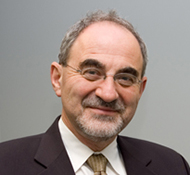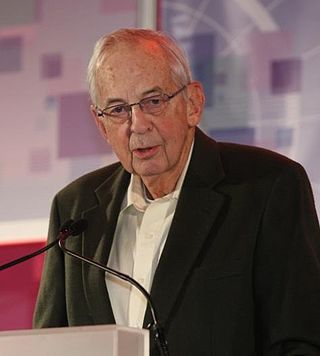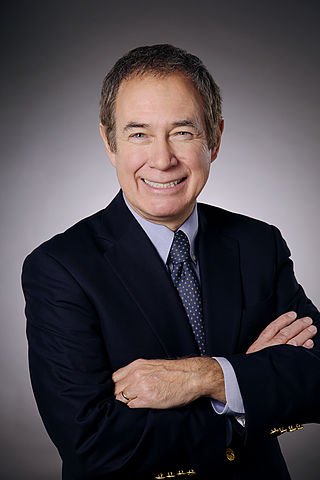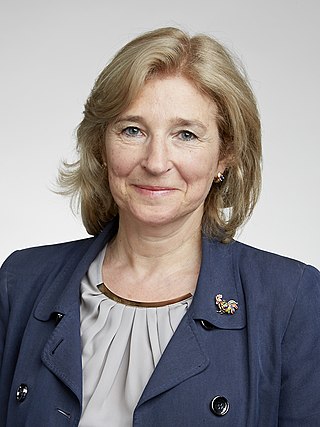Related Research Articles

Eli Yablonovitch is an American physicist and engineer who, along with Sajeev John, founded the field of photonic crystals in 1987. He and his team were the first to create a 3-dimensional structure that exhibited a full photonic bandgap, which has been named Yablonovite. In addition to pioneering photonic crystals, he was the first to recognize that a strained quantum-well laser has a significantly reduced threshold current compared to its unstrained counterpart. This is now employed in the majority of semiconductor lasers fabricated throughout the world. His seminal paper reporting inhibited spontaneous emission in photonic crystals is among the most highly cited papers in physics and engineering.
Sir David Neil Payne CBE FRS FREng is a British professor of photonics who is director of the Optoelectronics Research Centre at the University of Southampton. He has made several contributions in areas of optical fibre communications over the last fifty years and his work has affected telecommunications and laser technology. Payne’s work spans diverse areas of photonics, from telecommunications and optical sensors to nanophotonics and optical materials, including the introduction of the first optical fibre drawing tower in a university.

Tingye Li was a Chinese-American scientist in the fields of microwaves, lasers and optical communications. His innovative work at AT&T pioneered the research and application of lightwave communication, and has had a far-reaching impact on information technology for over four decades.
The John Tyndall Award is given to the "individual who has made pioneering, highly significant, or continuing technical or leadership contributions to fiber optics technology". The award is named after John Tyndall (1820-1893), who demonstrated for the first time internal reflection.
Stewart David Personick is an American researcher in telecommunications and computer networking. He worked at Bell Labs, TRW, and Bellcore, researching optical fiber receiver design, propagation in multi-mode optical fibers, time-domain reflectometry, and the end-to-end modeling of fiber-optic communication systems.
Robert D. Maurer is an American industrial physicist noted for his leadership in the invention of optical fiber.

Robert Louis Byer is a physicist. He was president of the Optical Society of America in 1994 and of the American Physical Society in 2012.

Kenneth O. Hill is a Mexican Canadian physicist who specializes in the field of photonics. In the late 1970s, he discovered the phenomena of photosensitivity in optical fiber and has worked extensively in its applications. He first demonstrated Fiber Bragg gratings and their applications in optical communication and optical sensor systems. Further areas of his discovery and innovation include the phase mask technique for grating fabrication, fiber grating dispersion compensators, and wavelength selective fiber filters, multiplexers and demultiplexers. This field of research has led to the ability to create high speed fiber optic networks as well as many other communication applications that have revolutionized the telecommunications industry.
Takanori Okoshi is a noted Japanese professor of electrical engineering, now retired, and an amateur composer of over 30 pieces of chamber music for quartet or sextet.

James Power Gordon was an American physicist known for his work in the fields of optics and quantum electronics. His contributions include the design, analysis and construction of the first maser in 1954 as a doctoral student at Columbia University under the supervision of C. H. Townes, development of the quantal equivalent of Shannon's information capacity formula in 1962, development of the theory for the diffusion of atoms in an optical trap in 1980, and the discovery of what is now known as the Gordon-Haus effect in soliton transmission, together with H. A. Haus in 1986. Gordon was a member of the National Academy of Engineering and the National Academy of Sciences.

Paul R. Prucnal is an American electrical engineer. He is a professor of electrical engineering at Princeton University. He is best known for his seminal work in Neuromorphic Photonics, optical code division multiple access (OCDMA) and the invention of the terahertz optical asymmetric demultiplexor (TOAD). He is currently a fellow of IEEE for contributions to photonic switching and fiber-optic networks, Optical Society of America and National Academy of Inventors.

Yasuharu Suematsu is a researcher and educator in optical communication technology. His research has included the development of Dynamic Single Mode Semiconductor Lasers for actuation and the development of high-capacity, long-distance optical fiber communications technology.

Polina Leopoldovna Bayvel is a British engineer and academic. She is currently Professor of Optical Communications & Networks in the Department of Electronic and Electrical Engineering at University College London. She has made major contributions to the investigation and design of high-bandwidth multiwavelength optical networking.

Anurag Sharma is an Indian physicist and a professor at the department of physics of the Indian Institute of Technology Delhi. He is known for his pioneering researches on optoelectronics and optical communications and is an elected fellow of all the three major Indian science academies viz. Indian Academy of Sciences, Indian National Science Academy and National Academy of Sciences, India as well as Indian National Academy of Engineering. The Council of Scientific and Industrial Research, the apex agency of the Government of India for scientific research, awarded him the Shanti Swarup Bhatnagar Prize for Science and Technology, one of the highest Indian science awards for his contributions to Engineering Sciences in 1998.
Ranjan Kumar Mallik is an Indian electrical and communications engineer and a professor at the Department of Electrical Engineering of the Indian Institute of Technology, Delhi. He held the Jai Gupta Chair at IIT Delhi from 2007 to 2012 and the Brigadier Bhopinder Singh Chair from 2012 to 2017. He is known for his researches on multiple-input multi-output systems and is an elected fellow of all the three major Indian science academies viz. Indian Academy of Sciences, Indian National Science Academy, and The National Academy of Sciences, India. He is also an elected fellow of The World Academy of Sciences, Indian National Academy of Engineering, and The Institute of Electrical and Electronics Engineers, Inc.
Govind P. Agrawal is an Indian American physicist and a fellow of Optica, Life Fellow of the IEEE, and Distinguished Fellow of the Optical Society of India. He is the recipient of James C. Wyant Professorship of Optics at the Institute of Optics and a professor of physics at the University of Rochester. He is also a Distinguished scientist at the Laboratory for Laser Energetics (LLE) in the University of Rochester. Agrawal has authored and co-authored several highly cited books in the fields of non-linear fiber optics, optical communications, and semiconductor lasers.

John E. Bowers is an American physicist, engineer, researcher and educator. He holds the Fred Kavli Chair in Nanotechnology, the director of the Institute for Energy Efficiency and a distinguished professor in the Departments of Electrical and Computer Engineering and Materials at University of California, Santa Barbara. He was the deputy director of American Institute of Manufacturing of Integrated Photonics from 2015 to 2022.

Herbert Graves Winful is a Ghanaian-American engineering professor, whose honours include in 2020 the Quantum Electronics Award. He is the Joseph E. and Anne P. Rowe Professor of Electrical Engineering, Arthur F. Thurnau Professor of Electrical Engineering and Computer Science, and a Professor of Physics at the University of Michigan.
Yanne Kouomou Chembo is an electrical engineer and associate professor at the University of Maryland, College Park. His research considers ultra-pure microwaves and Kerr frequency combs. He is a Fellow of The Optical Society and SPIE.
Masataka Nakazawa is a Japanese researcher in optical communication engineering. He is a distinguished professor at Tohoku University in Japan. His pioneering work on erbium-doped fiber amplifier (EDFA) has made a significant contribution to the development of global long-distance, high-capacity optical fiber network.
References
- 1 2 3 "Kazuro Kikuchi Wins 2014 John Tyndall Award". osa.org. The Optical Society. December 9, 2013. Retrieved 2 January 2018.
- 1 2 "2013 Newly Elevated Fellow" (PDF). IEEE . Institute of Electrical and Electronics Engineers. Archived from the original (PDF) on December 24, 2012.
- ↑ "Honorary Member - Kazuro Kikuchi". ieice.org. Institute of Electronics, Information and Communication Engineers . Retrieved 2 January 2018.
- ↑ "NEC C&C Foundation - 2013 C&C Prize Ceremony". canc.or.jp. NEC C&C Foundation. Retrieved 2 January 2018.